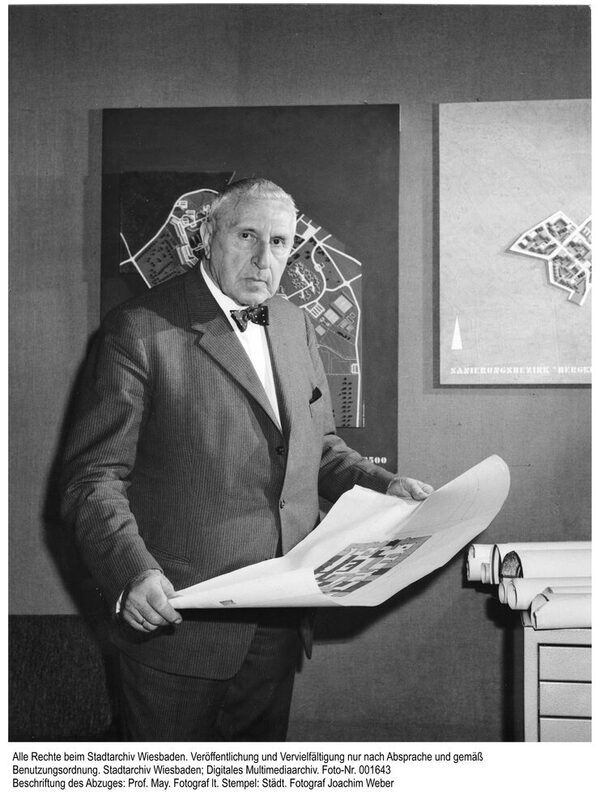May, Ernst
May, Ernst
Architect, town planner
Born: 27.07.1886 in Frankfurt am Main
died: 11.09.1970 in Hamburg
The son of a leather manufacturer, he studied architecture at University College London from 1907 to 1913, at the Technical University of Darmstadt and under Friedrich von Thiersch and Theodor Fischer at the Technical University of Munich. From 1914, he worked as a freelance architect in Frankfurt. In 1919, he became technical director of the Silesian Land Company in Breslau, where he was responsible for the construction of rural settlements. In 1925, he was appointed city planning officer and head of the building construction and settlement office in Frankfurt. He had a ten-year program drawn up to address the housing shortage and implemented it until the Great Depression: Trabant housing estates and mixed developments with typified small apartments and a rationalized construction process allowed for low rents, reasonable comfort, open spaces and greenery. "Das Neue Frankfurt" - the title of a magazine founded by May - was regarded as the realization of social aspirations in the New Building of the Weimar Republic.
In 1930, May was appointed as an urban planner for new industrial cities in the USSR, but his designs were criticized. From 1934 to 1953, he lived as a farmer and architect in Kenya. From 1954 to 1956, he was head of the planning department at Neue Heimat in Hamburg. From 1957, he worked as an independent architect, urban planner and consultant for Neue Heimat in Bremen and Mainz, among other places.
In 1961, he was appointed planning commissioner for Wiesbaden and drew up a general development plan for the city, which he presented to the city council on July 5, 1962. May planned Klarenthal, Schelmengraben, Am Parkfeld in Biebrich and Wolfsfeld in Bierstadt as new housing estates(large housing estates), which were gradually realized. The plan showed May's influence on building in the 1920s, which had deliberately set itself apart from the architecture of the Wilhelmine era. Much of the building fabric from this period had been preserved in Wiesbaden, which May wanted to deal with radically. The Bergkirche district was to be demolished - with the exception of the Bergkirche - and replaced by modern residential buildings in a looser style with individual high-rise buildings. In place of the residential area to the east of Paulinenstrasse and Mainzer Strasse, high-rise office buildings were to be built: a new office city called "City Ost". The S-Bahn connection to Frankfurt's Hauptwache was to begin south of the Warmen Damm. The building block between Wagemannstrasse and Grabenstrasse (Schiffchen) was to be demolished in favor of parking spaces.
These plans were not implemented. In Klarenthal in particular, the social problems of a new satellite housing estate soon became apparent, which is why the Bergkirchen district with its established residential environment was preserved and redeveloped. A citizens' initiative was formed against the "City Ost" plans, which succeeded in preserving the area as a residential and mixed-use area.
Among the numerous honors that Ernst May received were the Grand Cross of the Order of Merit of the Federal Republic of Germany in 1954 and the Badge of Honor of the State Capital of Wiesbaden in 1966.
Literature
- Magistrat der Landeshauptstadt Wiesbaden
The new Wiesbaden. Urban development is not a state, but a process, Wiesbaden 1963.
- Jung, Wolfgang
Urban planning in Wiesbaden. Fantasies, models and conflicts in the 20th century. In: Everyday life, culture and big politics. Wiesbadener Stadtgeschichte in Quellen und Kommentaren, Vol. 2: Vom Ersten Weltkrieg bis zur Gegenwart, published by the Hessian Institute for Teacher Training, Wiesbaden Branch, Wiesbaden 1997 (pp. 112-126).
- Quiring, Claudia u.a. (Hrsg.)
Ernst May 1886 - 1970, Munich, London, New York 2011.
